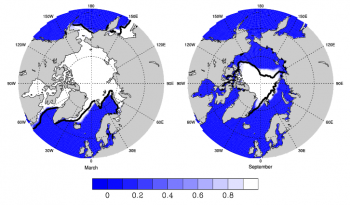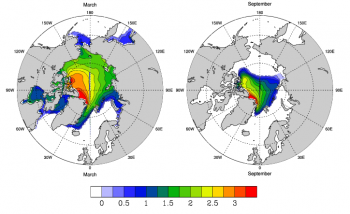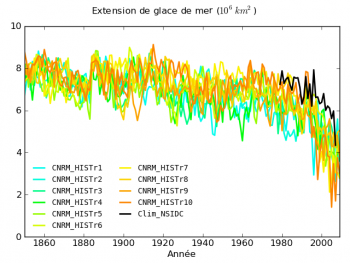Sea ice model
Description
GELATO numerical model (Global Experimental Leads and ice for ATmosphere and Ocean) describes the dynamics and thermodynamics of Arctic and Antarctic sea ice. Using such a model allows to study e.g. the variability of sea ice, or to better understand the recent shrinking of the Arctic sea ice that is observed since the 1990s. In this context, a record low sea ice extent of about 4 million km was observed in 2007, to be compared with 7-8 million km in the 1980s.

It was primarily developed from 1996 under the name of ICESTATE (a contribution to the ICESTATE EU project), beginning from a simple thermodynamic sea ice model used at NERSC (Bergen, Norway).
Written in Fortran90, its first version includes a subgrid representation of sea ice thickness distribution (ITD), and a representation of snow accumulation over ice slabs, following Douville (1995a, 1995b).
This model was first used as a regional model, without sea ice dynamics. In 1997, a simple free-drift formulation of sea ice dynamics (i.e. not taking sea ice internal stresses into account) was coupled to ICESTATE, leading to a more comprehensive -and global- model called GELATO.
Since 2000, GELATO uses the state of the art Elastic-Viscous-Plastic dynamics (EVP), developed by Hunke et Dukowicz (1997). The semi-lagrangian (or incremental remapping) advection used by the model is described in Hunke and Lipscomb (2002).
In this model sea ice energy and mass conservation has received considerable attention, as these features are essential for the use of a sea ice model, particularly in coupled applications. The reference paper describing GELATO is Salas-Mélia (2002).
More recently, new physical processes were taken into account in GELATO version 5: sea ice salinity now changes in time, and the specific heat of sea ice is now a function of temperature and salinity. Work is in progress to implement melt ponds. These ponds are observed during the summer and contribute to the amplification of surface sea ice melting.

Applications
Directly embedded in the ocean general circulation model NEMO3.2, GELATO5 is currently the sea ice component of CNRM’s global coupled climate model, CNRM-CM5, for the following applications:
– climate simulations of past and present climates (Last Glacial Maximum, Mid-Holocene, preindustrial and 1850-present)
– future climate change simulations according to various greenhouse gases and atmospheric aerosols concentration scenarios (present to 2300)
– seasonal and decadal sea ice predictions (research)

GELATO is also coupled with a 1D slab ocean model (a representation of the upper 50m of the ocean). In this framework, GELATO still considers the dynamics of sea ice, but in this case the model must be constrained by a relaxation of surface temperature and/or sea ice thickness, to compensate biases due to the lack of heat transport in the slab ocean model.
GELATO is hightly portable and runs on PC, VPP Fujitsu, NEC SX and IBM regatta.
Collaborations
– NERSC (Bergen, Norway)
– Los Alamos Laboratory (USA)
Publications associated with this model
Douville, H., Royer, J.-F. and Mahfouf, J.-F. (1995a): A new snow parametrization for the Météo-France climate model. Part I: Validation in stand-alone experiments, Clim. Dyn. 12, 21-35
Douville, H., Royer, J.-F. and Mahfouf, J.-F. (1995b): A new snow parametrization for the Météo-France climate model. Part II: Validation in a 3-D GCM experiments, Clim. Dyn. 12, 37-52
Guemas, V. and D. Salas y Melia, 2008: Simulation of the Atlantic Meridional Overturning Circulation in an Atmosphere-Ocean Global Coupled Model, Part I: A Mechanism Governing the Variability of Ocean Convection in a Preindustrial Experiment. Climate Dyn. 31(1), 29-48. doi: 10.1007/s00382-007-0336-8
Guemas, V. and D. Salas y Melia, 2008: Simulation of the Atlantic Meridional Overturning Circulation in an Atmosphere-Ocean Global Coupled Model, Part II: Weakening in a Climate Change Experiment: a Feedback Mechanism. Climate Dyn. 30(7-8), 831-844. doi: 10.1007/s00382-007-0328-8
Hunke, E.C. and Dukowicz, J.K. (1997): An elastic-viscous-plastic model for sea ice dynamics. J. Phys. Oceanogr., 27, 1849-1867.
Hunke, E.C. and Lipscomb, W.-H. (2002): CICE: the Los Alamos sea ice model, documentation and software User’s Manual. T-3 Fluid Dynamics Group, Los Alamos National Laboratory, Tech. Rep. LACC-98-16 v.3.
Salas-Mélia, D. (2000): Développement et validation d’un modèle couplé océan-glace de mer pour l’étude du climat des hautes latitudes. Thèse de doctorat de l’Univ. P. Sabatier, Toulouse III.
Salas-Mélia, D. (2002): A global coupled sea ice-ocean model. Ocean Modelling 4, 137-172.
Salas-Mélia, D., F. Chauvin, M. Déqué, H. Douville, J.-F. Gueremy, F. Chauvin, S. Planton, J.-F. Royer and S. Tyteca (2005): Description and validation of the CNRM-CM3 global coupled model, CNRM Tech. Rep. 103.



